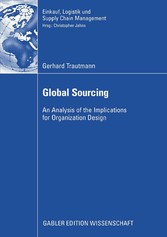Suchen und Finden
III. Implementing Global Sourcing Through Purchasing Portfolio Management (S. 45-46)
Abstract
Competing globally, an issue for companies is to adapt their organizational structures and governance in increasingly complex organizations. At the functional level of purchasing, companies turn to hybrid purchasing organizations in order to leverage global sourcing benefits. One of the key challenges in this context is to distinguish between categories to be integrated across sites and those remaining under the authority of each purchasing location in order to maximize purchasing synergies. The aim of the paper is to present a purchasing portfolio model that provides a comprehensive view of relevant global synergy dimensions.
Based on a literature review, a theoreticallygrounded purchasing portfolio model for global sourcing is developed, going beyond the well-established Kraljic matrix for classifying purchasing categories. The validity of the model is explored by means of a single in-depth case study. Complementing the extant literature, the theoretical contribution of the paper lies in not only addressing category selection criteria for exploiting economies of scale, but also for economies of information &, learning and economies of process.
Keywords: Global sourcing, purchasing synergy, organization design, portfolio mode, Case study
1. Introduction
Multinational companies can no longer compete as a collection of nationally independent subsidiaries, since competition is based on the ability of the firm to integrate its subsidiary activities across geographical locations (Porter, 1986, Ohmae 1989, Bartlett and Ghoshal, 1989, Nohria and Ghoshal, 1997, Kotabe and Murray, 2004). Since the seminal paper of Malnight (1995), which put forward that globalization occurs at the level of the function, international business research has increasingly set the focus on analyzing how global integration is attained for functions, such as R&,D, marketing or manufacturing (Nobel and Birkinshaw, 1998, Sheth and Parvatiyar, 2001, Kim et al., 2003, Xu et al., 2006).
To our best knowledge, international business scholars have not put the centre of attention on purchasing. Looking at research on internationalization in the purchasing context, interest from practice and academia in global sourcing, defined as the integration of purchasing requirements across worldwide locations (Monczka and Trent, 1991), has been rising constantly during the last years. While some scholars argue that global sourcing is critical for achieving competitive advantage (Alguire et al., 1994, Carter and Narasimhan, 1996, Quintens et al., 2006b), studies have also identified that global sourcing is gaining a more prominent role on the agenda of an increasing number of firms (Samli et al., 1998, Trent and Monczka, 2003).
The rationale to engage in global sourcing is based on two sources of competitive advantage: location-specific advantages, such as access to local supply and labour markets or new technologies and company-specific competencies, which are developed through the exploitation of global synergies, such as pooling of common requirements across sites (Arnold, 1997, Faes et al., 2000, Kotabe and Murray, 2004).
Alle Preise verstehen sich inklusive der gesetzlichen MwSt.









